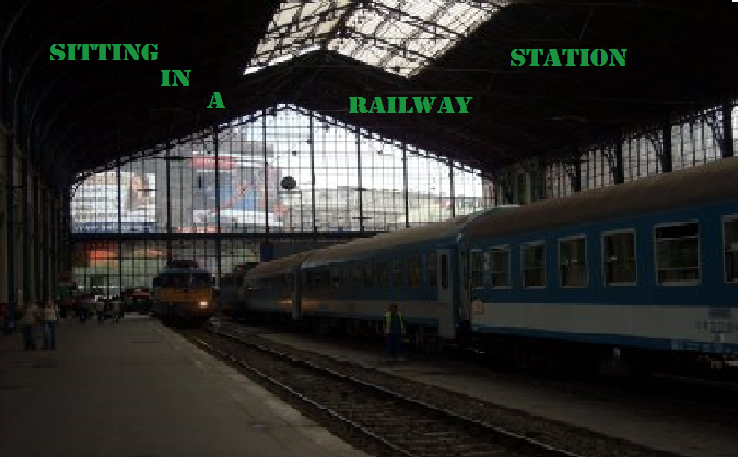Auschwitz, the retired concentration/death camp, has now been transformed into a museum. To think of such a site as a museum seems strange. One usually thinks of a museum as a place of art, or artifacts of history, something you wake up one morning and think, "Hm, it would be fun to plan a trip next week or tomorrow, to go to such and such a museum for an afternoon." However, one doesn't usually wake up and think, "Today I will visit the site of the holocaust." However, being a part of history and a rather dramatic one at that, not wanting it to fade the place has been preserved for its memory.
The way the museum was laid out was effective, and I was pleased (such as one can be pleased) in the manner in which it is presented. The museum, in a description of the trips events:
The day was cold, and grey. A rather cliché atmosphere. We got our guide, put on a headphone set with a little radio so we could hear her through a mike she had on, and set out into the camp. We began at Auschwitz I, the first camp built. We walked along the side of a double electric fence, topped with barbed wire, and old guard tours spaced along the side. On my first impression, the place seems rather small. For all the statistics we read, all the stories we hear, one would expect something larger. Though once inside, the vastness of prison blocks they fit in the area is still rather notable. We come to the metal gate. The famous sign bends over the entrance: "Arbeit macht frei" - "Work makes you free." -- a phrase well known by the prisoners, and very much there to mock them, as in they were typically told upon arrival that work was until their death. The buildings are all made of red brick. We pass the place where an orchestra once played, from which all the prisoners were meant to march. The prison blocks have been transformed into houses for exhibitions of historical evidence. The roads were mostly made of stone, and uneven to walk on. Inside they have displays of papers and forms. They have maps showing the layout of the camp, along with Auschwitz II, located a few kilometers away. The more shocking exhibitions include a room with a long glass case along the entire side, displaying hair. Before gassing the prisoners, they would have their head shaven, and these would be collected and sold to be used for manufacturing in rugs or cloths. After the war, much of the hair was found. Similar cases hold shoes (mostly black or grey, but an occasional red one could be found in the pile), luggage, personal belongings, glasses. We then walked over to the edge of the camp, where we entered Block 11, which served as a prison within the prison. Here prisoners were trialed, prisoned in standing cells, but more often shot at the shooting wall right outside. The actual wall had been destroyed, and there is now a reconstruction made of stones. All along the bottom are flowers and burning candles, where people have placed there small memorials. We walked back along the camp to the center street, where prisoners stood for role call every morning. Here there was also a gallows used for public executions. Our final stop at this camp was a walk through one of the gas chambers and crematories. We walked into a door over a small hill (an old Polish bunker the Germans transformed for their use), turn to the right into a room, then turn into the left into the chamber. There were only a few large square holes at the top where gas would be let in, once covered with shower heads. The walls were scratched by nails. Then we walked out of the room into the crematory, much like furnaces, with a contraption than can be wheeled into it.
After a short break, to buy some coffee from a machine and some people visit the restrooms, we drove over to Auschwitz II-Birkenau. The entrance had two rail way tracks leading into a center area of gravel, where prisoners would be separated into different sections of the camp. As to what I said above about size, this camp seemed to justify the statistics to a much more dramatic level. On the rail way is an original box car that would have brought the prisoners from all over Europe. The camp is split into sections. The prison blocks here had been built out of wood, with brick heating stretching along the inside. Not really built to last, but on the contrary, built to be hidden, all the buildings for the most part have been destroyed over time, and what is available is more of a reconstruction from what was left. First we stopped in the toilet/shower room, where prisoners would have a matter of minutes to do their needs with no privacy. Then a short look in one of the sleeping areas, stretched with three level bunk beds. We walked to the end of the camp to two more gas chambers, which are now a pile of rubble. After the camp was liberated the chambers were bombed, and have been left as they were. In between the two chambers is a memorial, with plaques along it saying the same message in several languages. The English plaque reading: "Forever let this place be a cry of despair and a warning to humanity where the Nazis murdered about one and a half million men, women and children, mainly Jews, from various countries of Europe." Then we left, feeling hungry, and ready for lunch.

No comments:
Post a Comment